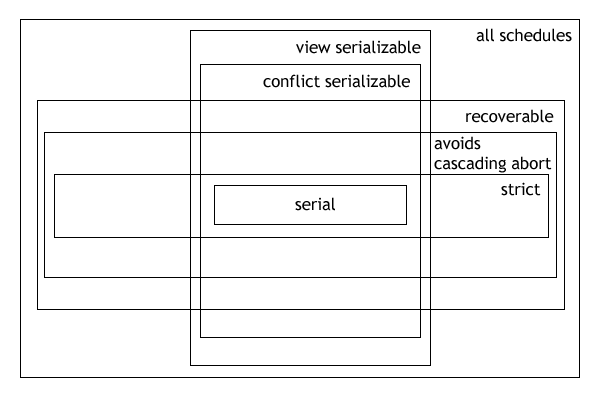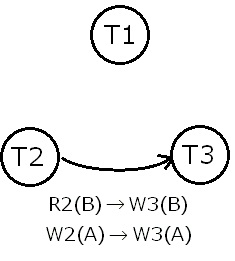|
Schedule (computer Science)
In the fields of databases and transaction processing (transaction management), a schedule (or history) of a system is an abstract model to describe execution of transactions running in the system. Often it is a ''list'' of operations (actions) ordered by time, performed by a set of transactions that are executed together in the system. If the order in time between certain operations is not determined by the system, then a ''partial order'' is used. Examples of such operations are requesting a read operation, reading, writing, aborting, committing, requesting a lock, locking, etc. Not all transaction operation types should be included in a schedule, and typically only selected operation types (e.g., data access operations) are included, as needed to reason about and describe certain phenomena. Schedules and schedule properties are fundamental concepts in database concurrency control theory. Formal description The following is an example of a schedule: ;D In this example, the ... [...More Info...] [...Related Items...] OR: [Wikipedia] [Google] [Baidu] |
Database
In computing, a database is an organized collection of data stored and accessed electronically. Small databases can be stored on a file system, while large databases are hosted on computer clusters or cloud storage. The design of databases spans formal techniques and practical considerations, including data modeling, efficient data representation and storage, query languages, security and privacy of sensitive data, and distributed computing issues, including supporting concurrent access and fault tolerance. A database management system (DBMS) is the software that interacts with end users, applications, and the database itself to capture and analyze the data. The DBMS software additionally encompasses the core facilities provided to administer the database. The sum total of the database, the DBMS and the associated applications can be referred to as a database system. Often the term "database" is also used loosely to refer to any of the DBMS, the database system or an app ... [...More Info...] [...Related Items...] OR: [Wikipedia] [Google] [Baidu] |
Precedence Graph
A precedence graph, also named conflict graph and serializability graph, is used in the context of concurrency control in databases. The precedence graph for a schedule S contains: * A node for each committed transaction in S * An arc from Ti to Tj if an action of Ti precedes and Schedule (computer science)#Conflicting actions, conflicts with one of Tj's actions. That is the actions belong to different transactions, at least one of the actions is a write operation, and the actions access the same object (read or write). Precedence graph examples Example 1 :S = \begin T1 & T2 \\ R(A) & R(A) \\ A=A*5 & R(B) \\ W(A) & B=B+A \\ R(B) & W(B) \\ B=B*10 & \\ W(B) & \\ \end Example 2 :D = R1(A) R2(B) W2(A) Com.2 W1(A) Com.1 W3(A) Com.3 A precedence graph of the schedule D, with 3 transactions. As there is a cycle (of length 2; with two edges) through the committed transactions T1 and T2, this Schedule (computer science), schedule (history) is ''not'' ... [...More Info...] [...Related Items...] OR: [Wikipedia] [Google] [Baidu] |
Gerhard Weikum
Gerhard Weikum is a Research Director at the Max Planck Institute for Informatics in Saarbrücken, Germany, where he is leading the databases and information systems department. His current research interests include transactional and distributed systems, self-tuning database systems, data and text integration, and the automatic construction of knowledge bases. He is one of the creators of the YAGO knowledge base. He is also the Dean of the International Max Planck Research School for Computer Science (IMPRS-CS). Earlier he held positions at Saarland University in Saarbrücken, Germany, at ETH Zurich, Switzerland, at MCC in Austin, Texas, and he was a visiting senior researcher at Microsoft Research in Redmond, Washington. He received his diploma and doctoral degrees from the TU Darmstadt, Germany. He acted as the President of the VLDB endowment in 2005 and 2006. The endowment organizes the yearly ''International Conference on Very Large Databases'', a scientific conferenc ... [...More Info...] [...Related Items...] OR: [Wikipedia] [Google] [Baidu] |
Phil Bernstein
Philip Alan Bernstein is a computer scientist specializing in database research in the Database Group of Microsoft Research. Bernstein is also an affiliate professor at the University of Washington and frequent committee member or chair of conferences such as VLDB and SIGMOD. He won the SIGMOD Edgar F. Codd Innovations Award in 1994,1994 SIGMOD Edgar F. Codd Innovations Award and in 2011 with Jayant Madhavan and Erhard Rahm the VLDB 10 Year Best Paper Award for their VLDB 2001 paper "Generic Schema Matching with Cupid". Bernstein was elected a member of the |
Schedule (project Management)
In project management, a schedule is a listing of a project's milestones, activities, and deliverables. Usually dependencies and resources are defined for each task, then start and finish dates are estimated from the resource allocation, budget, task duration, and scheduled events. A schedule is commonly used in the project planning and project portfolio management parts of project management. Elements on a schedule may be closely related to the work breakdown structure (WBS) terminal elements, the Statement of work, or a Contract Data Requirements List. Overview In many industries, such as engineering and construction, the development and maintenance of the project schedule is the responsibility of a full-time scheduler or team of schedulers, depending on the size and the scope of the project. The techniques of scheduling are well developed but inconsistently applied throughout industry. Standardization and promotion of scheduling best practices are being pursued by ... [...More Info...] [...Related Items...] OR: [Wikipedia] [Google] [Baidu] |
Venn Diagram
A Venn diagram is a widely used diagram style that shows the logical relation between sets, popularized by John Venn (1834–1923) in the 1880s. The diagrams are used to teach elementary set theory, and to illustrate simple set relationships in probability, logic, statistics, linguistics and computer science. A Venn diagram uses simple closed curves drawn on a plane to represent sets. Very often, these curves are circles or ellipses. Similar ideas had been proposed before Venn. Christian Weise in 1712 (''Nucleus Logicoe Wiesianoe'') and Leonhard Euler ('' Letters to a German Princess'') in 1768, for instance, came up with similar ideas. The idea was popularised by Venn in ''Symbolic Logic'', Chapter V "Diagrammatic Representation", 1881. Details A Venn diagram may also be called a ''set diagram'' or ''logic diagram''. It is a diagram that shows ''all'' possible logical relations between a finite collection of different sets. These diagrams depict elements as points in ... [...More Info...] [...Related Items...] OR: [Wikipedia] [Google] [Baidu] |
Serializability
In concurrency control of databases, Philip A. Bernstein, Vassos Hadzilacos, Nathan Goodman (1987)''Concurrency Control and Recovery in Database Systems''(free PDF download), Addison Wesley Publishing Company, Gerhard Weikum, Gottfried Vossen (2001)''Transactional Information Systems'' Elsevier, transaction processing (transaction management), and various transactional applications (e.g., transactional memoryMaurice Herlihy and J. Eliot B. Moss. ''Transactional memory: architectural support for lock-free data structures.'' Proceedings of the 20th annual international symposium on Computer architecture (ISCA '93). Volume 21, Issue 2, May 1993. and software transactional memory), both centralized and distributed, a transaction schedule is serializable if its outcome (e.g., the resulting database state) is equal to the outcome of its transactions executed serially, i.e. without overlapping in time. Transactions are normally executed concurrently (they overlap), since this is the mos ... [...More Info...] [...Related Items...] OR: [Wikipedia] [Google] [Baidu] |
NP-complete
In computational complexity theory, a problem is NP-complete when: # it is a problem for which the correctness of each solution can be verified quickly (namely, in polynomial time) and a brute-force search algorithm can find a solution by trying all possible solutions. # the problem can be used to simulate every other problem for which we can verify quickly that a solution is correct. In this sense, NP-complete problems are the hardest of the problems to which solutions can be verified quickly. If we could find solutions of some NP-complete problem quickly, we could quickly find the solutions of every other problem to which a given solution can be easily verified. The name "NP-complete" is short for "nondeterministic polynomial-time complete". In this name, "nondeterministic" refers to nondeterministic Turing machines, a way of mathematically formalizing the idea of a brute-force search algorithm. Polynomial time refers to an amount of time that is considered "quick" for a dete ... [...More Info...] [...Related Items...] OR: [Wikipedia] [Google] [Baidu] |
Blind Write
In computing Computing is any goal-oriented activity requiring, benefiting from, or creating computing machinery. It includes the study and experimentation of algorithmic processes, and development of both hardware and software. Computing has scientific, ..., a blind write occurs when a transaction writes a value without reading it. Any view serializable schedule that is not conflict serializable must contain a blind write. In particular, a write wi(X) is said to be blind if it is not the last action of resource X and the following action on X is a write wj(X). Transaction processing {{Compu-prog-stub ... [...More Info...] [...Related Items...] OR: [Wikipedia] [Google] [Baidu] |
The History Of Commitment Ordering
''The'' () is a grammatical article in English, denoting persons or things already mentioned, under discussion, implied or otherwise presumed familiar to listeners, readers, or speakers. It is the definite article in English. ''The'' is the most frequently used word in the English language; studies and analyses of texts have found it to account for seven percent of all printed English-language words. It is derived from gendered articles in Old English which combined in Middle English and now has a single form used with pronouns of any gender. The word can be used with both singular and plural nouns, and with a noun that starts with any letter. This is different from many other languages, which have different forms of the definite article for different genders or numbers. Pronunciation In most dialects, "the" is pronounced as (with the voiced dental fricative followed by a schwa) when followed by a consonant sound, and as (homophone of pronoun ''thee'') when followed by a ... [...More Info...] [...Related Items...] OR: [Wikipedia] [Google] [Baidu] |
Weikum2001
Gerhard Weikum is a Research Director at the Max Planck Institute for Informatics in Saarbrücken, Germany, where he is leading the databases and information systems department. His current research interests include transactional and distributed systems, self-tuning database systems, data and text integration, and the automatic construction of knowledge bases. He is one of the creators of the YAGO knowledge base. He is also the Dean of the International Max Planck Research School for Computer Science (IMPRS-CS). Earlier he held positions at Saarland University in Saarbrücken, Germany, at ETH Zurich, Switzerland, at MCC in Austin, Texas, and he was a visiting senior researcher at Microsoft Research in Redmond, Washington. He received his diploma and doctoral degrees from the TU Darmstadt, Germany. He acted as the President of the VLDB endowment in 2005 and 2006. The endowment organizes the yearly ''International Conference on Very Large Databases'', a scientific conferenc ... [...More Info...] [...Related Items...] OR: [Wikipedia] [Google] [Baidu] |



.png)